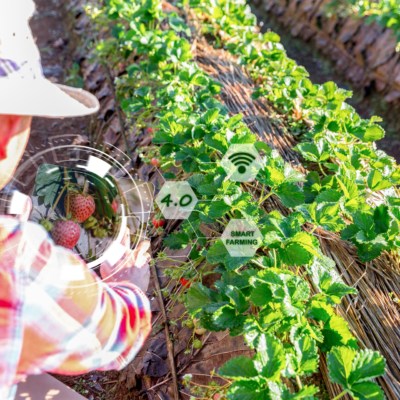
In the ever-evolving world of agriculture, technology is transforming how farmers manage their crops, livestock, and overall farm operations. As we step into 2025, smart farming tools are no longer a luxury but a necessity for US farmers who wish to stay competitive and sustainable. These tools leverage advancements in technology, such as artificial intelligence (AI), the Internet of Things (IoT), and machine learning, to improve efficiency, reduce costs, and increase crop yield. Below, we explore some of the top smart farming tools that are revolutionizing the industry in the United States.
1. Drones for Precision Farming
Drones have quickly become one of the most valuable tools in modern farming. These unmanned aerial vehicles (UAVs) allow farmers to monitor large areas of crops with precision. Drones equipped with high-resolution cameras and sensors can provide farmers with detailed images of their fields, detecting areas of stress in crops, such as pest infestations or water deficiencies. This technology allows farmers to target problem areas directly, saving time, reducing the use of pesticides and water, and improving overall crop health.
For instance, a drone can quickly survey hundreds of acres, creating a detailed map that highlights potential issues such as uneven crop growth or soil conditions. This data can then be used to make informed decisions about irrigation, fertilization, and pest control, resulting in higher yields and cost savings.

2. Smart Irrigation Systems
Water management has always been a critical concern for farmers, especially in regions where water scarcity is a growing issue. Smart irrigation systems have become one of the top smart farming tools used by US farmers in 2025. These systems utilize sensors, weather data, and AI algorithms to optimize water usage, ensuring that crops receive the right amount of water at the right time.
For example, smart irrigation systems can automatically adjust watering schedules based on real-time weather forecasts, soil moisture levels, and evapotranspiration rates. This reduces water wastage and lowers costs, making irrigation more efficient and environmentally friendly. In states like California, where water conservation is crucial, these systems are becoming essential for farmers to manage their resources effectively.
3. Automated Tractors and Harvesters
Automation in farming is taking huge strides forward in 2025, with automated tractors and harvesters becoming increasingly popular. These machines are equipped with GPS and AI to navigate fields without human intervention, reducing the need for manual labor and enhancing efficiency.
Automated tractors can perform tasks such as plowing, planting, and fertilizing, while harvesters are designed to pick crops like fruits and vegetables with minimal damage. These machines use sensors to detect when crops are ripe and ready for harvesting, ensuring that only the best produce is collected. This not only boosts productivity but also reduces the risk of human error, ultimately leading to higher-quality crops and better profit margins for farmers.
4. Livestock Monitoring Systems
For farmers who focus on livestock, smart farming tools are equally beneficial. Livestock monitoring systems, powered by IoT technology, allow farmers to track the health, behavior, and location of their animals in real-time. Wearable devices, such as collars or ear tags, can monitor vital signs like body temperature, heart rate, and activity levels, alerting farmers to any potential health issues before they become serious.
These monitoring systems can also help optimize feeding schedules, track breeding cycles, and manage overall herd health, improving the productivity and profitability of livestock operations. By receiving alerts and data on the go, farmers can act quickly to address any issues, ensuring that their animals remain healthy and productive.
5. Soil Sensors and Data Analytics
Understanding soil health is crucial for farmers who wish to maximize crop yield and maintain long-term soil fertility. Soil sensors, which are placed directly in the ground, measure factors like soil moisture, temperature, pH levels, and nutrient content. The data collected is then analyzed using AI-powered platforms to provide farmers with actionable insights on how to manage their soil more effectively.
For instance, if the soil is too acidic, farmers can use the data to apply the right type of fertilizer to correct the imbalance. Soil sensors also allow for precision agriculture, where inputs such as water, nutrients, and pesticides can be applied only where needed, reducing waste and improving crop quality. By regularly monitoring soil health, farmers can ensure that their land remains productive for years to come.
6. AI-Powered Crop Management Software
Crop management software that utilizes artificial intelligence is becoming increasingly important for farmers looking to optimize their operations. These software tools analyze data from various sources, including weather forecasts, soil sensors, and drone imagery, to provide farmers with real-time insights into crop health, growth patterns, and potential risks.
AI-powered crop management platforms can help farmers make data-driven decisions regarding planting schedules, fertilization, pest control, and harvest timing. By leveraging this technology, farmers can minimize crop loss, reduce input costs, and ultimately increase yields. The use of AI also allows farmers to predict trends and adjust their strategies accordingly, making their operations more adaptable to changing conditions.

7. Smart Greenhouses
In controlled environments like greenhouses, smart technology is revolutionizing how crops are grown. Smart greenhouses use sensors, AI, and IoT devices to control factors such as temperature, humidity, and light levels. This creates an optimal environment for crops, leading to faster growth and higher yields.
For example, a smart greenhouse can automatically adjust the temperature and humidity based on the needs of the plants inside. This level of control ensures that crops are grown in the most favorable conditions possible, even in regions with harsh climates. With the help of smart greenhouses, farmers can grow more produce year-round, even in areas where traditional farming methods would not be feasible.
8. Blockchain for Traceability and Supply Chain Transparency
Blockchain technology is making its way into agriculture, providing a secure and transparent way to track the journey of food from farm to table. By using blockchain, farmers can record and verify each step in the supply chain, ensuring that their products are traceable and free from fraud.
For consumers, this means greater confidence in the safety and authenticity of the food they purchase. For farmers, blockchain helps build trust with consumers and retailers, creating a more efficient and transparent supply chain. This technology is especially valuable for organic farmers who need to prove that their products meet specific standards.
Conclusion
Smart farming tools are revolutionizing the agriculture industry in the United States, providing farmers with the resources they need to increase efficiency, reduce costs, and improve crop yields. From drones and smart irrigation systems to AI-powered crop management software and livestock monitoring devices, these technologies are helping farmers stay competitive in a rapidly changing industry.
As we move further into 2025, it is clear that technology will continue to play a pivotal role in shaping the future of farming. By embracing these tools, farmers can not only boost their productivity but also contribute to more sustainable and environmentally friendly practices, ensuring that agriculture remains a vital and thriving industry for generations to come.
Also Read:- 10 High-Paying Side Hustles for US Residents in 2025





